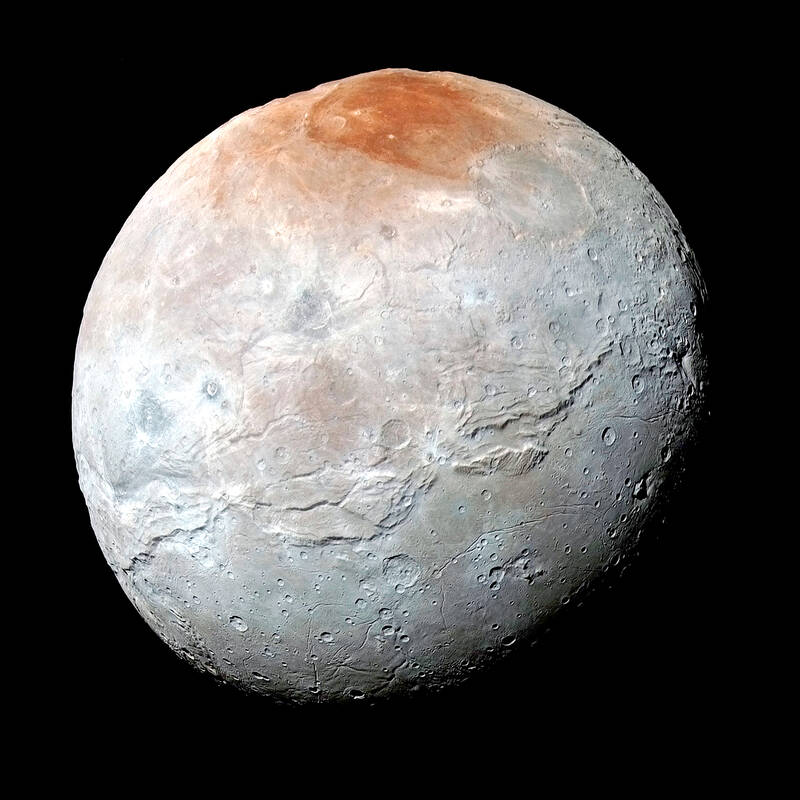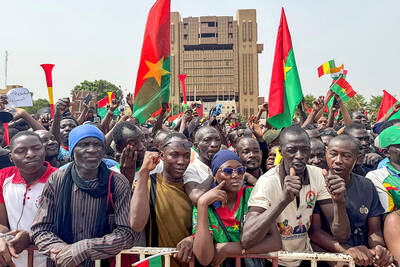Observations by the James Webb Space Telescope are giving scientists a fuller understanding about the composition of Pluto’s largest moon, Charon.
Webb for the first time detected carbon dioxide and hydrogen peroxide — both frozen as solids — on the surface of Charon, a spherical body about 1,200km in diameter, researchers said on Tuesday.
Those are added to the water ice, ammonia-bearing compounds and organic materials previously documented on the surface of Charon.

Photo: Reuters
Charon, discovered in 1978, has the distinction of being the solar system’s largest moon relative in size to the body it orbits. It is about half the diameter and one-eighth the mass of Pluto, a dwarf planet that resides in a frigid region of the outer solar system called the Kuiper Belt, beyond the most distant planet, Neptune.
The distance between Charon and Pluto is about 19,640km, compared with 384,400km on average separating Earth from its moon.
Most of Charon’s surface is gray, with reddish-brown regions around its poles composed of organic materials.
The Webb observations build on data obtained when NASA’s New Horizons spacecraft flew by Charon during its visit to the Pluto system in 2015. The new study tapped into the ability of Webb, which was launched in 2021 and began collecting data the following year, to observe across a greater range of wavelengths than previously available.
The presence of hydrogen peroxide speaks to the irradiation processes Charon has experienced, the researchers said, while the carbon dioxide is probably an original component dating to this moon’s formation.
The hydrogen peroxide formed as the water ice on the surface of Charon was chemically altered by the perpetual onslaught of ultraviolet radiation from the sun, as well as energetic particles from the solar wind and from galactic cosmic rays that traverse the universe, the researchers said.
The carbon dioxide observed by Webb was probably buried underneath the surface and exposed by impacts on Charon, they said.
The carbon dioxide is likely to have been part of the primordial material from which Charon and Pluto originally formed, they added.
Scientists had been surprised that carbon dioxide was not previously spotted.
“The detection of carbon dioxide was a satisfying confirmation of our expectations,” said Silvia Protopapa, assistant director of the department of space studies at the Southwest Research Institute in Boulder, Colorado, coinvestigator of the New Horizons mission and lead author of the study published in the journal Nature Communications.
“The detection of hydrogen peroxide on Charon was unexpected. I honestly did not anticipate finding evidence of it on the surface,” Protopapa said.
The new observations of Charon help tell a broader story about the celestial bodies populating our solar system.
“Every small body in the outer solar system is a unique piece of a larger puzzle that scientists are trying to put together,” Protopapa said.
The researchers used a Webb instrument called the Near-Infrared Spectrograph to make four observations in 2022 and last year, getting full coverage of Charon’s northern hemisphere.
“These new Webb observations add carbon dioxide and hydrogen peroxide to the known inventory of [Charon’s] surface components. Both of these provide insights into ongoing processes of irradiation and impact-driven resurfacing,” said study coauthor Ian Wong, staff scientist at the Space Telescope Science Institute in Baltimore, Maryland.

Kehinde Sanni spends his days smoothing out dents and repainting scratched bumpers in a modest autobody shop in Lagos. He has never left Nigeria, yet he speaks glowingly of Burkina Faso military leader Ibrahim Traore. “Nigeria needs someone like Ibrahim Traore of Burkina Faso. He is doing well for his country,” Sanni said. His admiration is shaped by a steady stream of viral videos, memes and social media posts — many misleading or outright false — portraying Traore as a fearless reformer who defied Western powers and reclaimed his country’s dignity. The Burkinabe strongman swept into power following a coup in September 2022

‘FRAGMENTING’: British politics have for a long time been dominated by the Labor Party and the Tories, but polls suggest that Reform now poses a significant challenge Hard-right upstarts Reform UK snatched a parliamentary seat from British Prime Minister Keir Starmer’s Labor Party yesterday in local elections that dealt a blow to the UK’s two establishment parties. Reform, led by anti-immigrant firebrand Nigel Farage, won the by-election in Runcorn and Helsby in northwest England by just six votes, as it picked up gains in other localities, including one mayoralty. The group’s strong showing continues momentum it built up at last year’s general election and appears to confirm a trend that the UK is entering an era of multi-party politics. “For the movement, for the party it’s a very, very big

A new online voting system aimed at boosting turnout among the Philippines’ millions of overseas workers ahead of Monday’s mid-term elections has been marked by confusion and fears of disenfranchisement. Thousands of overseas Filipino workers have already cast their ballots in the race dominated by a bitter feud between President Ferdinand Marcos Jr and his impeached vice president, Sara Duterte. While official turnout figures are not yet publicly available, data from the Philippine Commission on Elections (COMELEC) showed that at least 134,000 of the 1.22 million registered overseas voters have signed up for the new online system, which opened on April 13. However,

ENTERTAINMENT: Rio officials have a history of organizing massive concerts on Copacabana Beach, with Madonna’s show drawing about 1.6 million fans last year Lady Gaga on Saturday night gave a free concert in front of 2 million fans who poured onto Copacabana Beach in Rio de Janeiro for the biggest show of her career. “Tonight, we’re making history... Thank you for making history with me,” Lady Gaga told a screaming crowd. The Mother Monster, as she is known, started the show at about 10:10pm local time with her 2011 song Bloody Mary. Cries of joy rose from the tightly packed fans who sang and danced shoulder-to-shoulder on the vast stretch of sand. Concert organizers said 2.1 million people attended the show. Lady Gaga